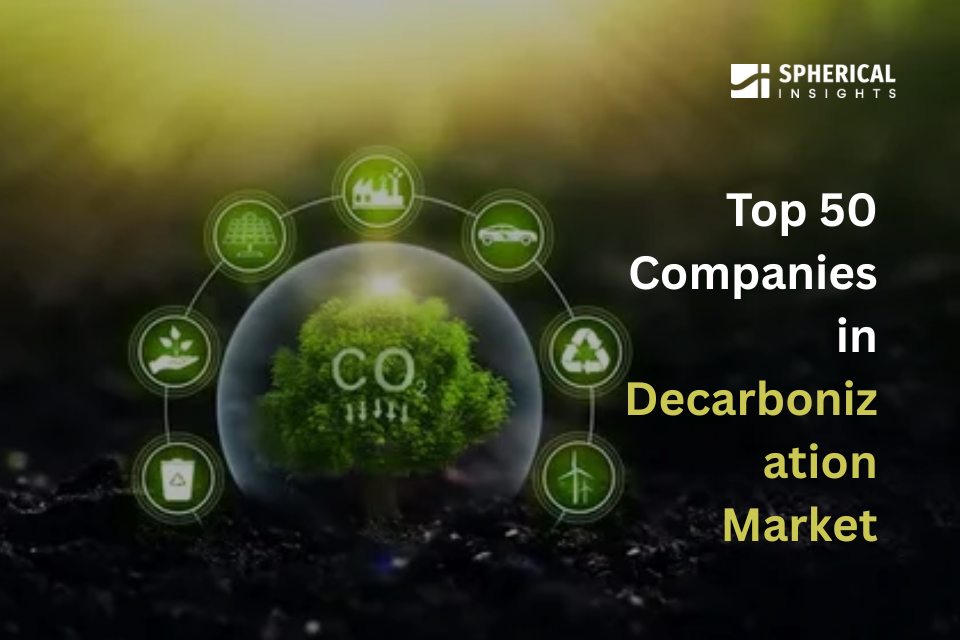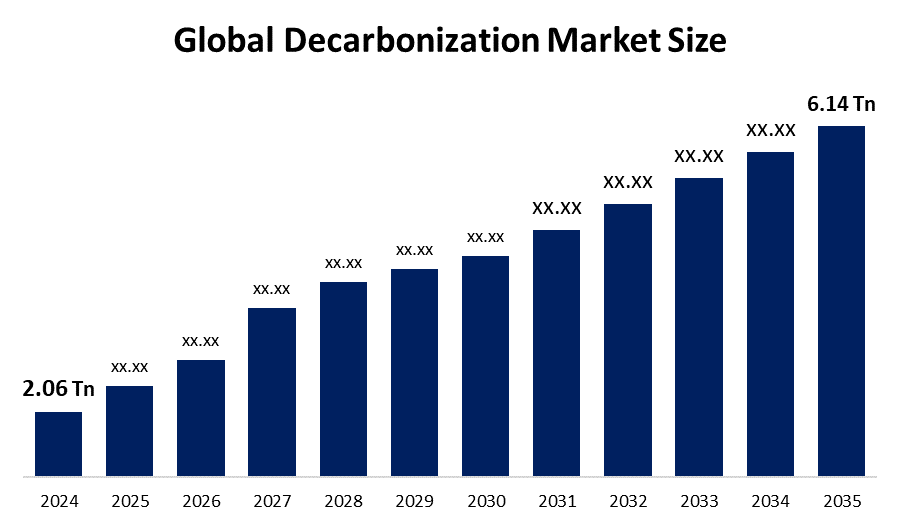
Top 50 Companies in Decarbonization Market: Spherical Insights Analysis
RELEASE DATE: Aug 2025 Author: Spherical InsightsRequest Free Sample Speak to Analyst
Description
According to a research report published by Spherical Insights & Consulting, The Global Decarbonization Market Size is projected to Grow from USD 2.06 Trillion in 2024 to USD 6.14 Trillion by 2035, at a CAGR of 10.44% during the forecast period 2025–2035. Regulations and corporate sustainability objectives are driving an increase in the use of decarbonization technologies such as carbon capture, green hydrogen, and sustainable fuels. Renewable energy infrastructure is increasing internationally, with investments in solar, wind, and grid upgrading, although emission reductions differ by location based on carbon policies.
Introduction
Decarbonization is the process of lowering or doing away with carbon dioxide emissions from a variety of industries, including transportation and energy, in order to slow down global warming. It entails switching from fossil fuel-based energy sources to renewable or low-carbon alternatives like solar, wind, hydro, and hydrogen. It also entails implementing carbon capture technology and increasing energy efficiency. A sustainable, low-carbon economy and reaching net-zero emission targets depend on decarbonization. The increase of the decarbonization sector is driven by the rise in carbon pricing and emissions trading systems (ETS), which provide financial incentives for businesses to lower their carbon footprint. Governments encourage companies to invest in cleaner technologies, energy efficiency, and low-carbon alternatives by reducing carbon emissions through policies like carbon taxes and cap-and-trade schemes. By enabling businesses to purchase and sell carbon allowances, emissions trading systems help market-based solutions by encouraging economical emission reductions. In order to stay competitive and adhere to changing regulations, industries are being forced to speed up their decarbonization efforts as more nations and regions implement strict carbon pricing policies. This is increasing demand for carbon capture technologies, renewable energy, and sustainable industrial practices.
Navigate Future Markets with Confidence: Insights from Spherical Insights LLP
The insights presented in this blog are derived from comprehensive market research conducted by Spherical Insights LLP, a trusted advisory partner to leading global enterprises. Backed by in-depth data analysis, expert forecasting, and industry-specific intelligence, our reports empower decision-makers to identify strategic growth opportunities in fast-evolving sectors. Clients seeking detailed market segmentation, competitive landscapes, regional outlooks, and future investment trends will find immense value in the full report. By leveraging our research, businesses can make informed decisions, gain a competitive edge, and stay ahead in the transition toward sustainable and profitable solutions.
Unlock exclusive market insights—Download the Brochure now and dive deeper into the future of the Decarbonization Market.
Decarbonization Market Size & Statistics
- The Market Size for Decarbonization was Estimated to be Worth USD 2.06 Trillion in 2024.
- The Market Size is Going to Expand at a CAGR of 10.44% between 2025 and 2035.
- The Global Decarbonization Market Size is anticipated to reach USD 6.14 trillion by 2035.
- North America is Expected to Generate the highest demand during the forecast period in the decarbonization market
- Asia Pacific is Expected to grow the fastest during the forecast period in the decarbonization market.

Regional growth and demand
Asia Pacific is expected to grow the fastest during the forecast period in the decarbonization market. With nations like China, India, Bangladesh, and Vietnam producing significant amounts of clothing and textiles, Asia Pacific is a center for the textile industry. This area is a top site for textile production worldwide because it has a huge labor force, plenty of raw resources, and cheaper production prices. In order to achieve quality and regulatory standards, the sheer volume of textile manufacturing in Asia Pacific needs the substantial usage of decarbonization for procedures including dyeing, finishing, and treating fabrics.
North America is expected to generate the highest demand during the forecast period in the decarbonization market. North America is renowned for its high standards of quality and sophisticated manufacturing capabilities. In order to meet regulatory norms and high-quality criteria, textile makers in the area use a variety of chemicals for procedures like dyeing, finishing, and treating fabrics. Technical textiles are becoming more and more in demand in North America due to industries like automotive, aerospace, healthcare, and industrial applications. The need for specialist decarbonization has increased since these textiles need sophisticated chemical treatments to improve qualities, including durability, flame resistance, and antibacterial qualities.
Top 10 trends in the Decarbonization Market
- Renewable Energy Advancements
- Carbon Capture and Storage Technologies
- Green Hydrogen Development
- Electrification of Transportation
- Energy Efficiency Solutions
- Low-Carbon Materials Adoption
- AI and Digital Tools for Emissions Monitoring
- Circular Economy Integration
- Climate-Driven Regulatory Policies
- Supply Chain Decarbonization
1. Renewable Energy Advancements
Solar, wind, hydro, and geothermal technologies are rapidly scaling due to falling costs and supportive policies. Innovations like floating solar farms, offshore wind platforms, and hybrid renewable systems are making clean energy more accessible and reliable across regions.
2. Carbon Capture and Storage Technologies
CCS is gaining traction as industries seek to reduce emissions from hard-to-abate sectors. Direct air capture, point-source scrubbing, and underground sequestration are being deployed to trap CarbonDioxide before it reaches the atmosphere. These technologies are critical for achieving net-zero goals.
3. Green Hydrogen Development
Produced using renewable electricity, green hydrogen is emerging as a clean fuel for industries, transport, and power generation. Advances in electrolyzer efficiency and infrastructure investment are making hydrogen a viable alternative to fossil fuels, especially in steel, chemicals, and aviation.
4. Electrification of Transportation
Electric vehicles (EVs), e-bikes, and electric public transit systems are reshaping mobility. Governments are incentivizing EV adoption, while battery technology improvements are extending range and reducing costs. This shift is key to cutting emissions from one of the largest polluting sectors.
5. Energy Efficiency Solutions
From smart grids to building automation, energy efficiency is one of the most cost-effective decarbonization strategies. Retrofitting infrastructure, optimizing industrial processes, and deploying IoT sensors help reduce energy waste and lower carbon footprints across sectors.
Empower your strategic planning:
Stay informed with the latest industry insights and market trends to identify new opportunities and drive growth in the decarbonization market. To explore more in-depth trends, insights, and forecasts, please refer to our detailed report.
Top 25 Companies Leading the Decarbonization Market
- Carbfix
- Carbon Clean
- Climeworks
- Carbon Engineering
- Aker Carbon Capture
- Shell
- Siemens Energy
- NextEra Energy
- Orsted
- TotalEnergies
- Air Liquide
- Bloom Energy
- ENGIE
- ExxonMobil Low Carbon Solutions
- Equinor
- Linde
- Enel
- Vestas
- GE Vernova
- Hyundai Heavy Industries
- Plug Power
- ABB
- bp
- Fortescue Future Industries
- Tata Steel
1. Carbfix
Headquarters - Reykjavik, Iceland
Carbfix is a pioneer in carbon capture and storage (CCS), transforming CARBONDIOXIDE into solid minerals underground. Headquartered in Reykjavik, Iceland, the company uses a unique method of dissolving Carbondioxide in water and injecting it into basalt rock formations, where it mineralizes within months. This natural process accelerates geological carbon sequestration, making Carbfix a global leader in low-carbon materials adoption. With partnerships across Europe and North America, Carbfix supports industries in achieving net-zero goals through scalable, cost-effective CCS solutions. Its technology is especially relevant for hard-to-abate sectors like cement and steel.
2. Carbon Clean
Headquarters - London, United Kingdom
Carbon Clean specializes in modular carbon capture technologies for industrial emitters. Based in London, the company offers proprietary solvent-based systems that reduce emissions from cement, steel, and chemical plants. Its compact units are designed for easy integration, supporting energy efficiency solutions and supply chain decarbonization. Carbon Clean’s technology has been deployed in over 40 sites globally, including collaborations in India and the U.S. The company’s focus on affordability and scalability makes it a key player in the race to decarbonize heavy industry.
3. Climeworks
Headquarters - Zurich, Switzerland
Climeworks is a global leader in direct air capture (DAC), removing CARBONDIOXIDE directly from the atmosphere. Headquartered in Zurich, Switzerland, Climeworks operates large-scale DAC plants powered by renewable energy, aligning with renewable energy advancements and AI-driven emissions monitoring. Its captured CARBONDIOXIDE is permanently stored underground or reused in synthetic fuels and materials. With clients like Microsoft and Stripe, Climeworks is helping corporations meet climate commitments through verified carbon removal. The company’s transparent lifecycle tracking and climate-positive mission position it at the forefront of the decarbonization movement.
4. Carbon Engineering
Headquarters - Calgary, Canada
Carbon Engineering develops scalable DAC systems that capture CARBONDIOXIDE for use in fuels and permanent storage. Based in Calgary, Canada, the company’s liquid-based capture process is designed for megaton-scale deployment, supporting climate-driven regulatory policies and green hydrogen development. Backed by major investors like Occidental and Airbus, Carbon Engineering is building one of the world’s largest DAC facilities in Texas. Its technology enables industries to offset emissions and produce low-carbon synthetic fuels, making it a cornerstone of future net-zero infrastructure.
5. Aker Carbon Capture
Headquarters - Oslo, Norway
Aker Carbon Capture delivers full-service carbon capture solutions for the industrial and energy sectors. Headquartered in Oslo, Norway, the company offers modular plants and offshore CCS systems tailored for the electrification of transportation and low-carbon materials. Aker’s Just Catch units are designed for rapid deployment and minimal disruption, making them ideal for retrofitting existing facilities. With strong ties to the European Green Deal and global climate initiatives, Aker is accelerating decarbonization across cement, waste-to-energy, and bioenergy sectors.
Are you ready to discover more about the decarbonization market?
The report provides an in-depth analysis of the leading companies operating in the global decarbonization market. It includes a comparative assessment based on their product portfolios, business overviews, geographical footprint, strategic initiatives, market segment share, and SWOT analysis. Each company is profiled using a standardized format that includes:
Company Profiles
- Carbfix
- Business Overview
- Company Snapshot
- Products Overview
- Company Market Share Analysis
- Company Coverage Portfolio
- Financial Analysis
- Recent Developments
- Merger and Acquisitions
- SWOT Analysis
- Carbon Clean
- Climeworks
- Carbon Engineering
- Aker Carbon Capture
- Shell
- Siemens Energy
- NextEra Energy
- Others.
Conclusion
The decarbonization market is on a strategic growth path, propelled by climate policies, carbon pricing, and innovations in clean energy and emissions reduction. Technologies such as green hydrogen, CCS, and smart infrastructure are transforming industrial operations and enabling sustainable economic transitions. Regional dynamics play a key role, with Asia Pacific emerging as a production powerhouse and North America driving demand through high-performance applications. With strong government support and corporate initiatives accelerating change, stakeholders must embrace data-driven strategies and emerging technologies to stay competitive. This evolving landscape offers powerful opportunities for global players shaping the low-carbon future.
About the Spherical Insights & Consulting
Spherical Insights & Consulting is a market research and consulting firm which provides actionable market research study, quantitative forecasting and trends analysis provides forward-looking insight especially designed for decision makers and aids ROI.
Which is catering to different industry such as financial sectors, industrial sectors, government organizations, universities, non-profits and corporations. The company's mission is to work with businesses to achieve business objectives and maintain strategic improvements.
CONTACT US:
For More Information on Your Target Market, Please Contact Us Below:
Phone: +1 303 800 4326 (the U.S.)
Phone: +91 90289 24100 (APAC)
Email: inquiry@sphericalinsights.com, sales@sphericalinsights.com
Contact Us: https://www.sphericalinsights.com/contact-us
Need help to buy this report?